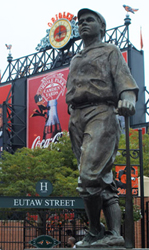Babe Ruth’s Impact on the Game of Baseball
In the early Twentieth Century, baseball was a very different game than the one we know today. Prior to the 1920’s, baseball management focused much more on the running game and strategically-placing balls as a hitting technique in order to score runs. Also, many times, the same ball would be used for the entire game, quickly becoming worn and beat up. This period was known as the “dead-ball era.” At the beginning of the 1920’s, however, Major League Baseball was looking to generate more excitement with the hitting aspect of the game. In 1920, Major League Baseball made a rule which required that balls be changed-out frequently throughout the game. In addition, the “spitball” pitch (considered to be one of a hitter’s worst enemies) became illegal in the Major Leagues.
In this same time frame, Babe was becoming recognized as more of a hitter, than a pitcher. In 1919, Babe hit 29 homeruns, establishing a new single season record for the number of homers hit by one player. What is more interesting about this particular record is that Babe’s 29 homeruns were also more than any other team hit, combined, that season.
The fans absolutely loved it. And, other players began to pay attention to his technique of full-swing hitting, as well as the significant results it produced. Many began to utilize a form of Babe’s swing and more and more balls began to fly out of the park.
Although by no means was it the only factor, Babe’s baseball-hitting style was certainly a contributor to the revolution of baseball and the “Live-Ball Era”. In fact, many baseball historians associate Babe somewhat synonymously with the homerun, because his hitting prowess had such an impact on players, managers, owners and fans alike and because it was big news at the same time as this major change in the style of play.
When you compare the some of the average stats for a player between 1918 (Near the end of the “Dead-Ball Era”) and 1921 (the beginning of live-ball), it’s clear that the game of baseball was changing:
1918: 1,989 stolen bases, 7,382 runs scored and 235 Homeruns
1921: 1,487 stolen bases, 11,928 runs scored and 937 Homeruns
 In three years time, stolen bases decreased 25%, runs scored increased 61% and homeruns increased almost 300%. Given the evolving approach, fans responded with an increased enthusiasm for the game. Attendance at ballparks improved significantly. In 1908, the New York Giants established the record for the most spectators in a season with close to 900,000 fans. In 1920, the Yankees broke that mark and set the new record of 1,289,422. In fact, ballclubs in six other cities broke their previous attendance records during that same year.
In three years time, stolen bases decreased 25%, runs scored increased 61% and homeruns increased almost 300%. Given the evolving approach, fans responded with an increased enthusiasm for the game. Attendance at ballparks improved significantly. In 1908, the New York Giants established the record for the most spectators in a season with close to 900,000 fans. In 1920, the Yankees broke that mark and set the new record of 1,289,422. In fact, ballclubs in six other cities broke their previous attendance records during that same year.
Baseball had evolved into a new, more offense-weighted game and Babe Ruth led the way. After his 29 homerun season in 1919, the Babe smacked 54 homers in 1920. And, in 1921, the Sultan of Swat blasted 59 balls over the wall or out of the park, breaking each of the records that he had set in the previous years.
Many fans acknowledge Babe Ruth as being a saving grace for baseball after the 1919 Black Sox Scandal. As one reporter wrote, “This new fan didn’t know where first base was, but he had heard of Babe Ruth and wanted to see him hit a home run. When the Babe hit one, the fan went back the next day and knew not only where first base was, but second base as well.”
Follow Us: